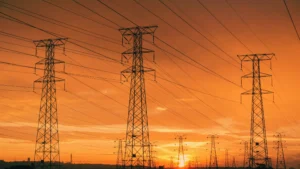How cities can plan for the energy transition
Historically, cities have been built on fossil fuels. They’ve powered our buildings, our transport and water systems, and everything else in between. Today, they’re responsible for three-quarters of all energy consumed and are facing significant adaptation challenges related to the energy transition.
Cities currently account for just over 50% of the global population, with that number expected to rise to nearly 70% by 2050. With the relatively large contribution to emissions related to critical infrastructure, they’re central to any efforts to transition to a net-zero future.
Luckily, cities often own and run (or at least strongly influence) this critical infrastructure, and are both the financiers and facilitators of renewable energy projects. They can enable the energy transition through a number of different means, like urban planning, housing and transport policies.
Back in 2017, when the U.S. government withdrew from the Paris climate accord, almost 300 cities and counties across the country picked up the baton and committed to taking action. Proving they have the power to set their own goals, map their own strategic plans and shape regulations.
What does the future hold?
As national governments reflect on the outcomes from the COP27 U.N. climate conference in Sharm El Sheikh, there are continued calls for accelerated action to cut emissions to meet the global climate goals, including by municipal authorities.
But while leaders know what they need to do, they are facing many challenges when it comes to how to achieve their goals.
Cities are complex. While they need to have an eye on the future, they also need to maintain the historic infrastructure that has been accumulating over the past 100 or more years, while balancing shrinking budgets with required levels of service.
Even though investments that support energy and environmental transition targets are critical, they need to fit in among an intricate web of policies and strategies. Showing benefits to the climate, citizen health and economic performance, without negatively affecting vulnerable stakeholders. Every step taken in the energy transition needs to address current and future inequalities.
This doesn’t mean transition projects should be abandoned at the first sign of difficulty, it means hurdles and conflicting interests need to be anticipated in advance.
Areas of opportunity
While there are challenges ahead, there are also plenty of opportunities. To maximize these opportunities, cities need to have a robust plan in place as a part of the energy transition, to ensure they can adapt to deliver a successful, sustainable future.
Lead the way on decarbonization
Cities across the globe are grappling with the urgent need to phase out coal-based energy grids and move towards a decarbonized energy supply, as they’re currently responsible for more than 70% of carbon dioxide emissions. Any meaningful move to renewable energy in cities will have a huge impact on these numbers.
Identifying the sources and ways to accurately measure and monitor them is the first step toward reducing them. They then need to commit to clean energy targets: 100% clean electricity by 2035, and 100% clean energy by 2050.
With technological advancements over the past decade, renewable energy options for cities have opened up and are rapidly gaining market traction.
Many cities are already taking their energy transition objectives seriously. In 2022, the CDP named 122 cities as leaders in environmental action and transparency, with 49 cities across North America being given the highest score for their vision, commitment and progress.
Scale distributed energy resources (DERs)
The most common types of DERs for cities are rooftop solar panels, electric vehicles (EVs) and battery storage. Their benefits include lower-cost energy, improved resiliency and increased integration of clean energy.
Cities have the power to test out projects on their own buildings, lands or assets, on a small scale, before scaling them to city-wide programs and initiatives. They can also encourage and incentivize local residents and businesses to do the same.
Knowledge sharing for the greater good
City planners and elected officials are always trying to do more with less. An antidote to this is learning from other cities that are similar to you in terms of climate, location, size or population.
There are often disparities in funding opportunities, with larger cities benefiting from more resources or infrastructure that encourages innovation. By collaborating, smaller cities can learn from the successes and failures of larger cities, and replicate or avoid them respectively during their own phases of implementation and deployment.
One network in particular, the C40 collective of major cities, is a network of decision-makers who work together on adopting strategies that promote renewable energy to build a more sustainable, resilient and equitable future. Their goal is to innovate, develop best practices and collaborate to influence global agenda and scale up climate action.
Key steps towards energy transition
While innovative, small-scale, projects are important as we transition, they will have little meaningful impact alone. They need to be supported by a framework of strong investment decisions and innovative technologies that scale-up and speed-up deployment. Here are a few examples of how that can happen.
Step 1: Digitalization
Clean energy transition plans begin with the digitization of a city’s data, subject matter expertise and decision policies. Once there is a digital business twin, cities can better operate and plan for the future. One way of doing this is by using capital planning software, like an asset investment planning solution.
With data, short-term metrics and long-term goals mapped out together in one platform, cities can monitor, evaluate and report on their progress, updating and collaborating with internal and external stakeholders and peers, alike.
Digitization goes hand in hand with the implementation of DERs too. A smart grid brings in a layer of flexibility, allowing end users to turn off certain appliances during peak times, or to join the centralized grid when other sources (like solar or wind) aren’t generating enough power.
Step 2: Long-term capital planning for reduced emissions
After cities create a digital business twin, they can easily map out different ‘what-if’ scenarios years, or even decades, into the future.
One of the mandates cities can have is to ensure the infrastructure in place guarantees everyone has access to affordable energy. They can achieve this by modeling different combinations of renewable energy sources, alongside fluctuating growth rates, and aligning the existing plans with future targets.
Blog: How does AIP help cities achieve long-term sustainability?
Step 3: Strategic investments that support the energy transition
Everything cities do needs to improve their resiliency to extreme weather events and the effects of climate change. The energy transition is no different. When it comes to critical infrastructure, proactive, timely and strategic investments are the only way to ensure cities meet their goals.
For the transition to be a success, cities need to maximize the value of their investments and to better understand the long-lasting impact of their decisions.
With data-driven insights, you’re able to compare all future investment outcomes and make the right decisions at the right time to preserve the safety, reliability, performance, and sustainability of all your assets.
Global transformation, starting on a local level
While they’re all working towards similar goals, there’s no single checklist for cities to follow to achieve a low-carbon future. They must each work alongside regional and national government partners, businesses and local communities to develop their own individual plans based on their context, resources and needs.
They can lead the transition by making the switch early to clean energy, maximizing the use of municipal buildings, running projects that showcase new technologies and pave the way to large-scale solutions that will have widespread, global benefits.
As the world continues its race to net zero, cities will continue to play a major role and must use the right solutions that allow them to make meaningful investments for their future. When they make the right investments, they’ll be safeguarding us all against environmental and economic challenges.



